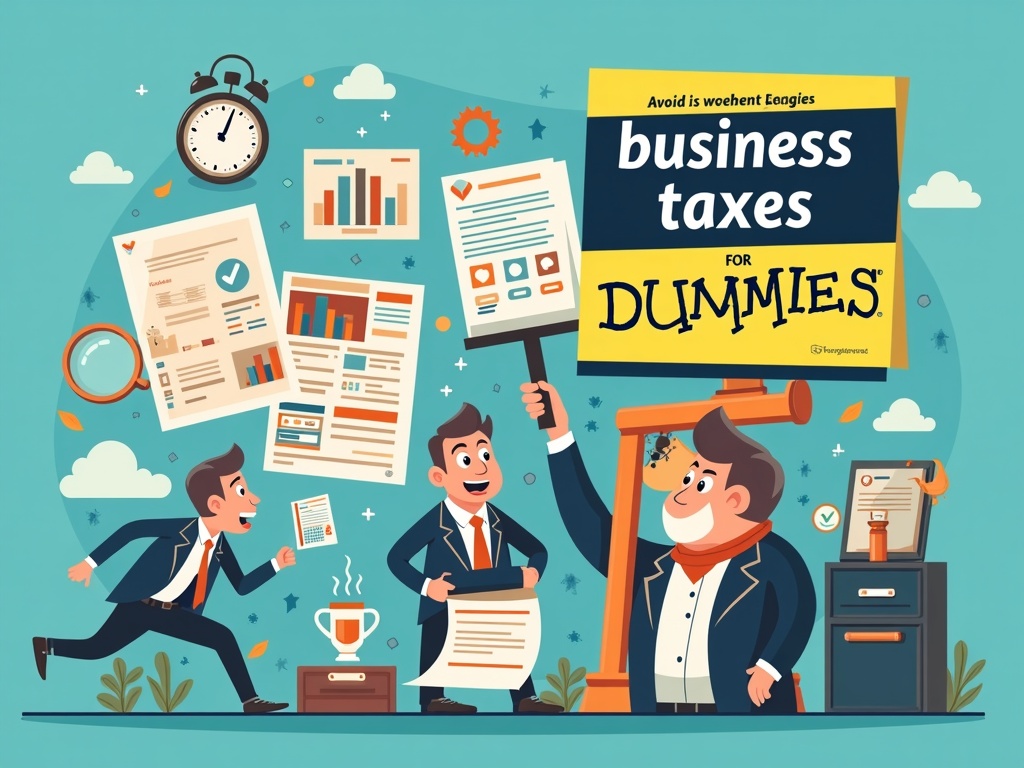Business Taxes for Dummies: A Simple Guide to Understanding Your Obligations
Running a business is a thrilling adventure, but let’s face it: taxes can feel like navigating a dense jungle with a dull machete. Fear not, intrepid entrepreneur! This guide breaks down business taxes for dummies into digestible, actionable steps. We’ll demystify the jargon, explore different business structures, and equip you with the knowledge to keep your business compliant and thriving.
Understanding the Basics of Business Taxes
Before diving into specifics, let’s establish a foundation. Business taxes are essentially payments made to federal, state, and sometimes local governments on the profits your business generates. These taxes fund public services like infrastructure, education, and defense. Ignoring them isn’t an option – it can lead to penalties, interest, and even legal trouble.
What are Taxable Business Activities?
Almost any activity that generates income is considered taxable. This includes:
**Sales of goods:Whether you sell handcrafted jewelry online or run a brick-and-mortar store, revenue from sales is taxable.
**Provision of services:If you’re a consultant, web designer, or offer any type of service, your earnings are taxable.
**Rental income:If you rent out property as part of your business, that income is taxed.
**Royalties:Earnings from intellectual property, like books or music, are also subject to taxation.
Key Tax-Related Terms You Should Know
Navigating the world of business taxes requires understanding some fundamental terms:
**Taxable Income:This is your revenue less allowable deductions.
**Deductions:Expenses you can subtract from your revenue to reduce your taxable income. Think of them as tax-lowering superheroes.
**Credits:Unlike deductions, credits directly reduce the amount of tax you owe. They’re like coupons for your tax bill!
**Estimated Taxes:Payments made throughout the year to cover your tax liability, rather than waiting until the end of the year.
**Tax Year:The period for which you’re reporting income and expenses. For most businesses, this is the calendar year (January 1st to December 31st).
Choosing the Right Business Structure and Its Tax Implications
Your business structure significantly impacts how you pay taxes. Here’s a look at common options:
Sole Proprietorship
**What it is:The simplest business structure, where the business is owned and run by one person, and there’s no legal separation between the owner and the business.
**Taxation:Profits are taxed as personal income using Schedule C of Form 1040. This is often referred to as pass-through taxation, meaning the income passes through the business to the owner’s personal tax return.
**Advantages:Simple to set up and manage.
**Disadvantages:Unlimited personal liability for business debts and obligations.
Partnership
**What it is:A business owned by two or more individuals who agree to share in the profits or losses of a business.
**Taxation:Similar to sole proprietorships, partnerships use pass-through taxation. The partnership files an informational return (Form 1065) and issues a Schedule K-1 to each partner, reporting their share of the income, deductions, and credits. The partners then report this information on their personal tax returns.
**Advantages:Combines resources and expertise of multiple individuals.
**Disadvantages:Potential for disagreements between partners, and partners may be held liable for the business debts and actions of other partners.
Limited Liability Company (LLC)
**What it is:A business structure that offers the liability protection of a corporation but with the pass-through taxation of a partnership or sole proprietorship.
**Taxation:LLCs can choose how they want to be taxed. They can be taxed as a sole proprietorship (if single-member), partnership (if multi-member), or even as a corporation (S Corp or C Corp).
**Advantages:Liability protection and flexibility in taxation.
**Disadvantages:Can be more complex to set up and maintain than sole proprietorships or partnerships.
S Corporation (S Corp)
**What it is:A corporation that has elected to pass its income, losses, deductions, and credits through to its shareholders for federal tax purposes.
**Taxation:Profits and losses are passed through to the owners’ personal income, avoiding double taxation (which occurs with C Corporations). Shareholders who are also employees must pay themselves a reasonable salary, subject to payroll taxes (Social Security and Medicare). The remaining profit can be taken as a distribution, which is not subject to self-employment taxes.
**Advantages:Potential tax savings compared to sole proprietorships, partnerships, or LLCs taxed as sole proprietorships or partnerships, especially if profits are high.
**Disadvantages:More complex to set up and maintain than other business structures, with stricter compliance requirements.
C Corporation (C Corp)
**What it is:A legal entity that is separate from its owners.
**Taxation:Subject to double taxation. The corporation pays income tax on its profits, and then shareholders pay income tax on any dividends they receive.
**Advantages:Can raise capital more easily than other business structures, offers the strongest liability protection.
**Disadvantages:Double taxation, more complex to set up and maintain than other business structures.
Essential Business Tax Forms
Familiarizing yourself with common tax forms will save you headaches down the road. Here are some crucial ones:
**Form 1040, Schedule C: Profit or Loss from Business (Sole Proprietorship):Used by sole proprietors to report business income and expenses.
**Form 1065: U.S. Return of Partnership Income: Used by partnerships to report their income, deductions, and credits.
**Form 1120: U.S. Corporation Income Tax Return:Used by C corporations to report their income, deductions, and credits.
**Form 1120-S: U.S. Income Tax Return for an S Corporation:Used by S corporations to report their income, deductions, and credits.
**Form 941: Employer’s Quarterly Federal Tax Return:Used to report payroll taxes withheld from employees’ wages, as well as the employer’s share of Social Security and Medicare taxes.
**Form W-2: Wage and Tax Statement:Provided to employees, reporting their annual wages and taxes withheld.
**Form 1099-NEC: Nonemployee Compensation:Used to report payments made to independent contractors.
Maximizing Deductions and Credits to Minimize Your Tax Burden
Deductions and credits are your allies in the quest to reduce your tax liability. Here are some common business deductions:
**Home Office Deduction:If you use a portion of your home exclusively and regularly for business, you may be able to deduct expenses related to that space.
**Business Expenses:Ordinary and necessary expenses directly related to your business are deductible. This includes things like rent, utilities, supplies, and advertising costs.
**Vehicle Expenses:You can deduct expenses related to using your vehicle for business purposes, either by tracking actual expenses or using the standard mileage rate.
**Insurance Premiums:Business insurance premiums, like liability insurance, are typically deductible.
**Startup Costs:You can deduct a portion of your startup costs in the first year of business.
**Depreciation:Allows you to deduct the cost of assets, like equipment or vehicles, over their useful life.
**Qualified Business Income (QBI) Deduction:This deduction allows eligible self-employed and small business owners to deduct up to 20% of their qualified business income.
Tax credits, on the other hand, directly reduce the amount of tax you owe. Some common business tax credits include the research and development (R&D) tax credit, the work opportunity tax credit (WOTC), and the energy tax credit.
Estimated Taxes: Paying as You Go
If you expect to owe $1,000 or more in taxes, you’re generally required to pay estimated taxes throughout the year. The IRS provides several methods for calculating estimated taxes, and it’s crucial to pay them on time to avoid penalties. Generally, estimated taxes are paid quarterly.
Record Keeping: Your Tax Season Lifesaver
Maintaining accurate and organized records is essential for tax time. This includes tracking all income and expenses, keeping receipts, and documenting business activities. Good record-keeping not only makes filing your taxes easier but also helps you identify potential deductions and credits.
Common Tax Mistakes to Avoid
Even the most diligent business owners can make tax mistakes. Here are some common pitfalls to watch out for:
**Mixing Business and Personal Expenses:Keep your business and personal finances separate to avoid complications and ensure accurate deductions.
**Missing Deadlines:Be aware of tax deadlines and file your returns on time to avoid penalties.
**Ignoring State and Local Taxes:Don’t forget about state and local taxes, which can vary depending on your location and business activities.
**Failing to Keep Adequate Records:As mentioned earlier, good record-keeping is crucial for accurate tax filing and claiming deductions.
**Incorrectly Classifying Workers:Be sure to correctly classify workers as either employees or independent contractors, as this affects your payroll tax obligations.
When to Seek Professional Help?
While this guide provides a solid foundation for understanding business taxes, there are times when it’s best to seek professional assistance. Consider hiring a tax advisor or accountant if:
You’re starting a new business.
You have a complex business structure.
You’re unsure about specific tax rules or deductions.
You’re facing an audit.
You simply want peace of mind knowing that your taxes are being handled correctly.
Final Thoughts
Business taxes don’t have to be a source of dread. By understanding the basics, choosing the right business structure, maximizing deductions and credits, and maintaining good records, you can navigate the tax landscape with confidence. And remember, when in doubt, don’t hesitate to seek professional help. With the right knowledge and resources, you can keep your business compliant and focused on what you do best: growing and thriving.





